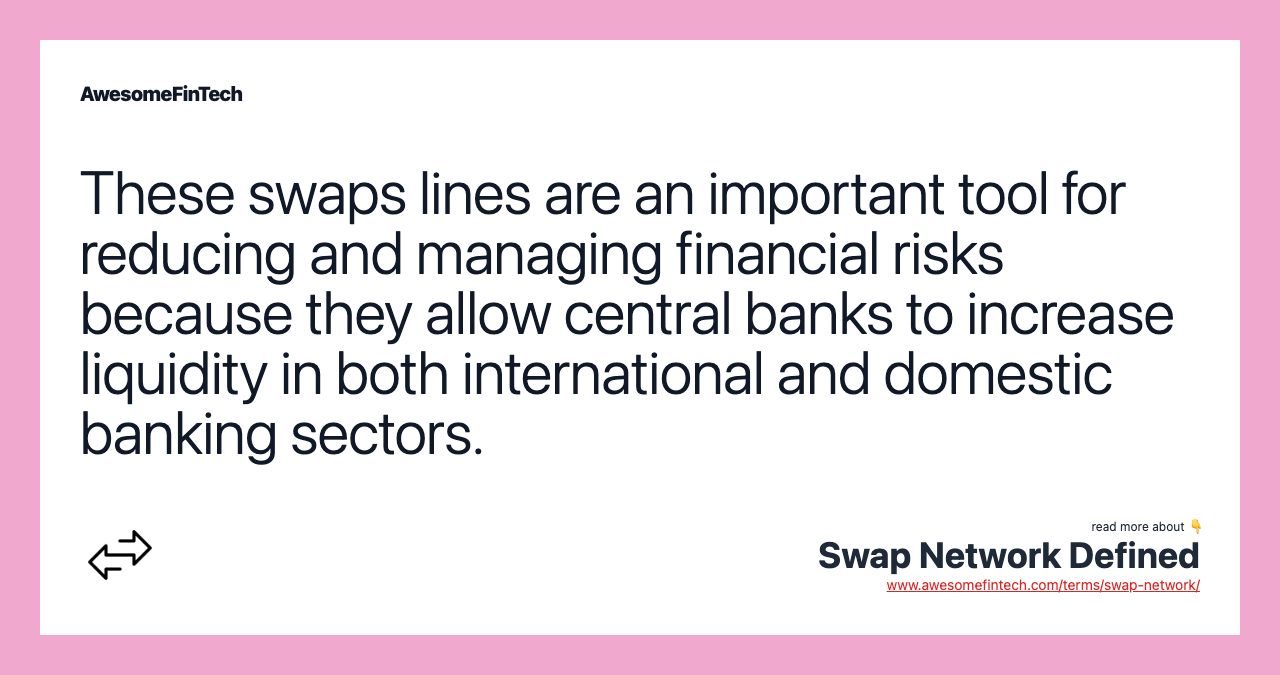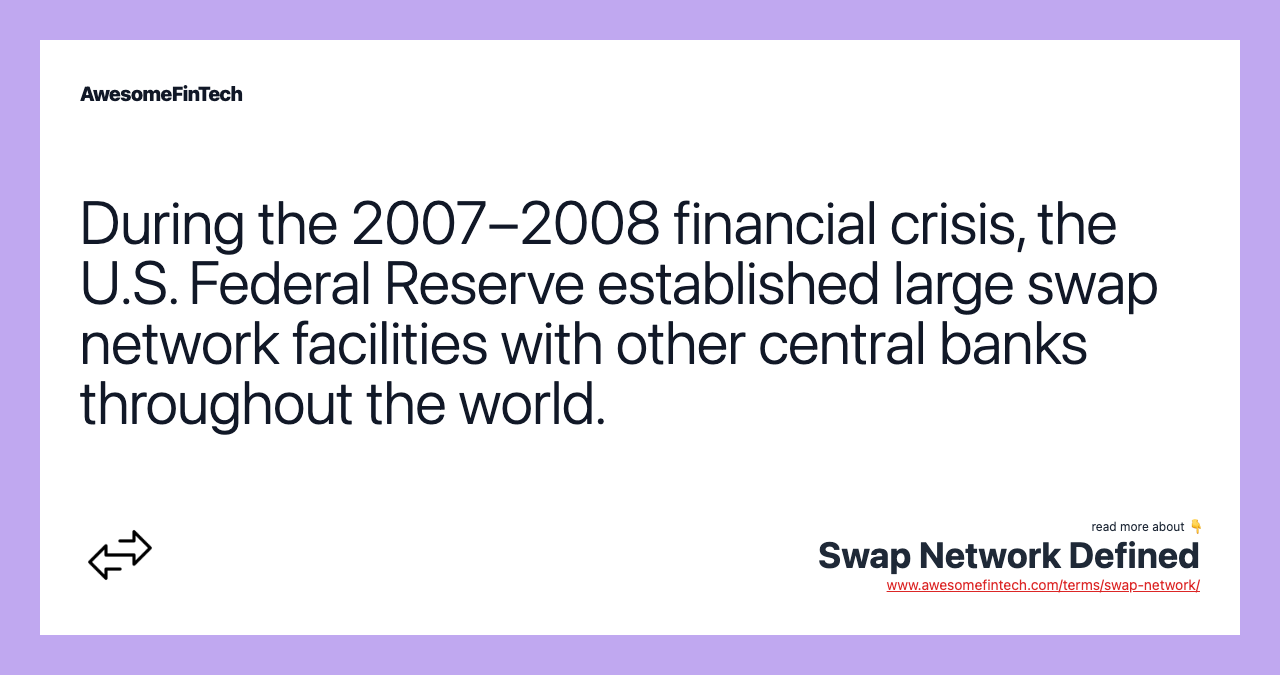Swap Network Defined
A swap network is a reciprocal credit line established between two or more central banks. In doing so, the Federal Reserve must also comply with the authorizations, policies, and procedures established by the Federal Open Market Committee (FOMC). During the 2007–2008 financial crisis, swap network arrangements were used extensively by central banks throughout the world. By lending currency between themselves and auctioning off the borrowed funds to private banks, central banks can influence the supply of currencies and thereby help lower the interest rate that banks charge when lending to each other. In Sept. 2008, at the height of the financial crisis, the Federal Reserve authorized a $180 billion increase to its swap network, thereby increasing its lines of credit with the central banks of Canada, England, and Japan. In the case of the ECB-PBOC swap network, the arrangement reduces the risk for eurozone banks with an international presence to do business in yuan; and vice versa for Chinese banks doing business in the eurozone.

What Is a Swap Network?
A swap network is a reciprocal credit line established between two or more central banks. The purpose of a swap network is to allow central banks to exchange currencies with each other in order to maintain a liquid and stable currency market.
Swap networks are also known as "currency swap lines," or as "temporary reciprocal currency arrangements."



Understanding Swap Networks
The purpose of a swap network is to maintain liquidity in foreign and domestic currencies so that commercial banks can maintain their mandated reserve requirements. By lending currency between themselves and auctioning off the borrowed funds to private banks, central banks can influence the supply of currencies and thereby help lower the interest rate that banks charge when lending to each other. This interest rate is known as the interbank rate.
Swap networks can play a critical role in maintaining financial-market stability when liquidity is otherwise strained, such as in the midst of a credit crunch. The swap network can help increase banks' access to affordable financing, which in turn can be passed on to businesses throughout the economy in the form of bank loans. For this reason, central banks are sometimes referred to as "the lender of last resort."
In the United States, the Federal Reserve operates swap networks under the authority granted to it by Section 14 of the Federal Reserve Act. In doing so, the Federal Reserve must also comply with the authorizations, policies, and procedures established by the Federal Open Market Committee (FOMC).
During the 2007–2008 financial crisis, swap network arrangements were used extensively by central banks throughout the world. At that time, central banks worldwide were desperate to improve liquidity conditions in the foreign exchange market and among domestic banks.
Real World Example of a Swap Network
In Sept. 2008, at the height of the financial crisis, the Federal Reserve authorized a $180 billion increase to its swap network, thereby increasing its lines of credit with the central banks of Canada, England, and Japan. Central banks the world over worked closely with each other to help prevent the crisis from spiraling out of control.
More recently, the European Central Bank (ECB) agreed in Oct. 2013 to establish a swap network with the People's Bank of China (PBOC). Under this agreement, the ECB extended euros worth about $50 billion to the PBOC, while the PBOC extended the same amount to the ECB in its own currency, the yuan.
While swap networks give central banks the ability to exchange currencies with one-another on demand, this does not mean that they will necessarily do so. Instead, the swap network provides a source of liquidity in the event of an emergency, reducing anxiety among banks and other market participants. In the case of the ECB-PBOC swap network, the arrangement reduces the risk for eurozone banks with an international presence to do business in yuan; and vice versa for Chinese banks doing business in the eurozone. In this manner, the establishment of a swap network is in part a way to instill investor confidence.
Related terms:
1913 Federal Reserve Act
The 1913 Federal Reserve Act created the current Federal Reserve System and introduced a central bank to oversee U.S. monetary policy. read more
Central Bank
A central bank conducts a nation's monetary policy and oversees its money supply. read more
Commercial Bank & Examples
A commercial bank is a financial institution that accepts deposits, offers checking and savings account services, and makes loans. read more
Credit Crunch
A credit crunch refers to a decline in lending activity by financial institutions brought on by a sudden shortage of funds. read more
Currency Board
A currency board is an extreme form of a pegged exchange rate. Often, it has directions to back all units of domestic currency with foreign currency. read more
Discount Rate
"Discount rate" has two distinct definitions. I can refer to the interest rate that the Federal Reserve charges banks for short-term loans, but it's also used in future cash flow analysis. read more
Dodd-Frank Wall Street Reform and Consumer Protection Act
Dodd-Frank Wall Street Reform and Consumer Protection Act is a series of federal regulations passed to prevent future financial crises. read more
Emergency Credit
Emergency credit is a government loan to a financial institution during a time of crisis. Such loans are often called bailout loans. read more
Euro
The European Economic and Monetary Union is comprised of 27 member nations, 19 of whom have adopted the euro (EUR) as their official currency. read more
European Central Bank (ECB)
The European Central Bank (ECB) is the consolidated central bank of the EU, coordinating the regions monetary policy efforts. read more